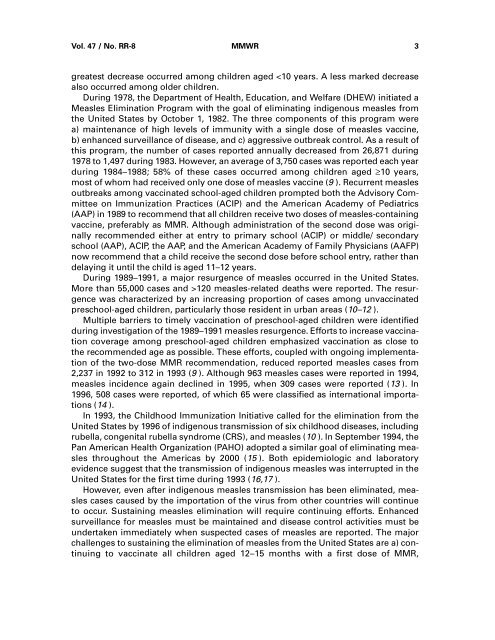Measles, Mumps, and Rubella - Centers for Disease Control and ...
Measles, Mumps, and Rubella - Centers for Disease Control and ...
Measles, Mumps, and Rubella - Centers for Disease Control and ...
You also want an ePaper? Increase the reach of your titles
YUMPU automatically turns print PDFs into web optimized ePapers that Google loves.
Vol. 47 / No. RR-8 MMWR 3greatest decrease occurred among children aged 120 measles-related deaths were reported. The resurgencewas characterized by an increasing proportion of cases among unvaccinatedpreschool-aged children, particularly those resident in urban areas (10–12 ).Multiple barriers to timely vaccination of preschool-aged children were identifiedduring investigation of the 1989–1991 measles resurgence. Ef<strong>for</strong>ts to increase vaccinationcoverage among preschool-aged children emphasized vaccination as close tothe recommended age as possible. These ef<strong>for</strong>ts, coupled with ongoing implementationof the two-dose MMR recommendation, reduced reported measles cases from2,237 in 1992 to 312 in 1993 (9 ). Although 963 measles cases were reported in 1994,measles incidence again declined in 1995, when 309 cases were reported (13 ). In1996, 508 cases were reported, of which 65 were classified as international importations(14 ).In 1993, the Childhood Immunization Initiative called <strong>for</strong> the elimination from theUnited States by 1996 of indigenous transmission of six childhood diseases, includingrubella, congenital rubella syndrome (CRS), <strong>and</strong> measles (10 ). In September 1994, thePan American Health Organization (PAHO) adopted a similar goal of eliminating measlesthroughout the Americas by 2000 (15 ). Both epidemiologic <strong>and</strong> laboratoryevidence suggest that the transmission of indigenous measles was interrupted in theUnited States <strong>for</strong> the first time during 1993 (16,17 ).However, even after indigenous measles transmission has been eliminated, measlescases caused by the importation of the virus from other countries will continueto occur. Sustaining measles elimination will require continuing ef<strong>for</strong>ts. Enhancedsurveillance <strong>for</strong> measles must be maintained <strong>and</strong> disease control activities must beundertaken immediately when suspected cases of measles are reported. The majorchallenges to sustaining the elimination of measles from the United States are a) continuingto vaccinate all children aged 12–15 months with a first dose of MMR,
















